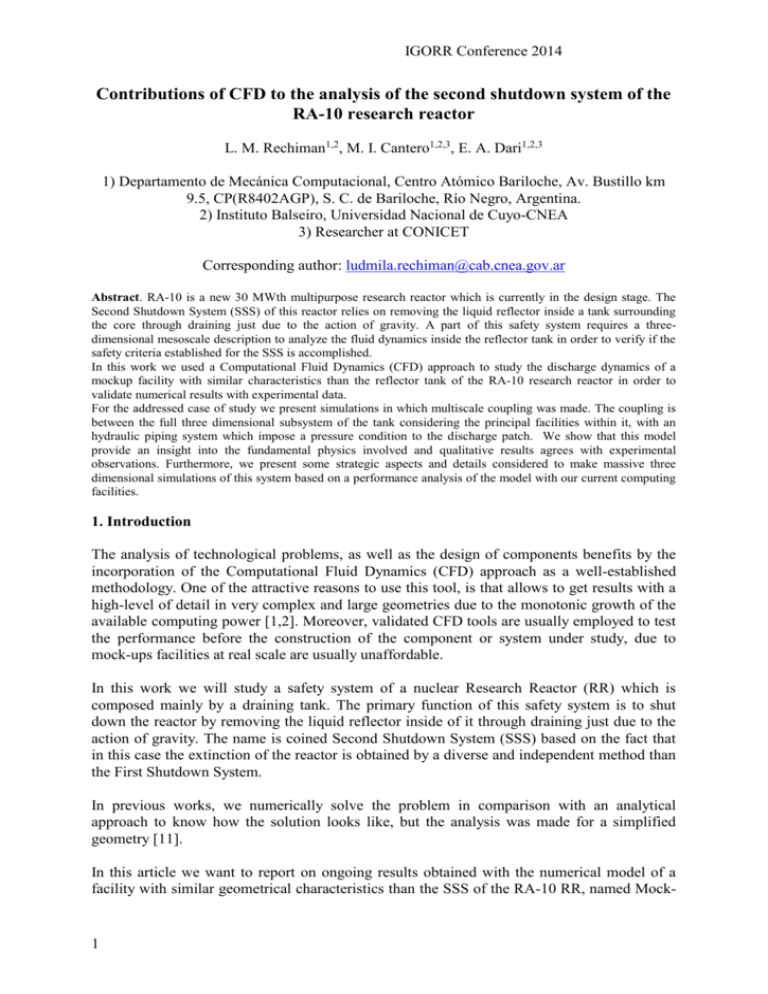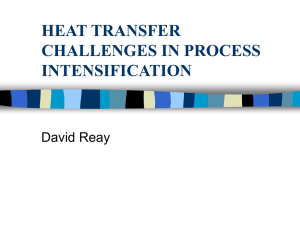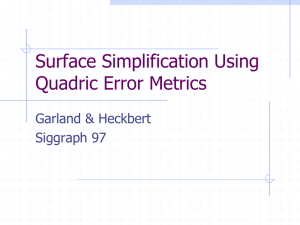
IGORR Conference 2014
Contributions of CFD to the analysis of the second shutdown system of the
RA-10 research reactor
L. M. Rechiman1,2, M. I. Cantero1,2,3, E. A. Dari1,2,3
1) Departamento de Mecánica Computacional, Centro Atómico Bariloche, Av. Bustillo km
9.5, CP(R8402AGP), S. C. de Bariloche, Río Negro, Argentina.
2) Instituto Balseiro, Universidad Nacional de Cuyo-CNEA
3) Researcher at CONICET
Corresponding author: ludmila.rechiman@cab.cnea.gov.ar
Abstract. RA-10 is a new 30 MWth multipurpose research reactor which is currently in the design stage. The
Second Shutdown System (SSS) of this reactor relies on removing the liquid reflector inside a tank surrounding
the core through draining just due to the action of gravity. A part of this safety system requires a threedimensional mesoscale description to analyze the fluid dynamics inside the reflector tank in order to verify if the
safety criteria established for the SSS is accomplished.
In this work we used a Computational Fluid Dynamics (CFD) approach to study the discharge dynamics of a
mockup facility with similar characteristics than the reflector tank of the RA-10 research reactor in order to
validate numerical results with experimental data.
For the addressed case of study we present simulations in which multiscale coupling was made. The coupling is
between the full three dimensional subsystem of the tank considering the principal facilities within it, with an
hydraulic piping system which impose a pressure condition to the discharge patch. We show that this model
provide an insight into the fundamental physics involved and qualitative results agrees with experimental
observations. Furthermore, we present some strategic aspects and details considered to make massive three
dimensional simulations of this system based on a performance analysis of the model with our current computing
facilities.
1. Introduction
The analysis of technological problems, as well as the design of components benefits by the
incorporation of the Computational Fluid Dynamics (CFD) approach as a well-established
methodology. One of the attractive reasons to use this tool, is that allows to get results with a
high-level of detail in very complex and large geometries due to the monotonic growth of the
available computing power [1,2]. Moreover, validated CFD tools are usually employed to test
the performance before the construction of the component or system under study, due to
mock-ups facilities at real scale are usually unaffordable.
In this work we will study a safety system of a nuclear Research Reactor (RR) which is
composed mainly by a draining tank. The primary function of this safety system is to shut
down the reactor by removing the liquid reflector inside of it through draining just due to the
action of gravity. The name is coined Second Shutdown System (SSS) based on the fact that
in this case the extinction of the reactor is obtained by a diverse and independent method than
the First Shutdown System.
In previous works, we numerically solve the problem in comparison with an analytical
approach to know how the solution looks like, but the analysis was made for a simplified
geometry [11].
In this article we want to report on ongoing results obtained with the numerical model of a
facility with similar geometrical characteristics than the SSS of the RA-10 RR, named Mock-
1
IGORR Conference 2014
up. Particularly, in this piece of work we will describe the modeling of the system under
study, as well as the strategic aspects and details considered to make massive three
dimensional simulations.
The paper is organized as follows: in Section (2) we will present details regarding the
technological problem, in Section (3) we describe the computational modeling of the mock-up
of the reflector tank, the main characteristics of the spatial discretization used in the following
calculations, and we will present the strategy used for parallel calculations. In Section (4) we
will present the ongoing results and the associated interpretation, and finally in Section (5) we
will sum up our conclusions.
2. General description of the problem
The study of this work focus on the description of the fluid dynamics inside a reflector tank of
an experimental nuclear reactor in order to verify if the safety criteria established for this
system is accomplished. In this work, we will work on an analogous facility of the SSS of the
RA-10 RR called Mock-up for which experimental data is available1 [3]. To model the
problem we made the decomposition in three subsystems according to the level of detail
required for each part:
Reflector tank. Full three-dimensional description
Discharge hydraulic piping system. Zero-dimensional description
Pressure equalization line. Zero-dimensional description.
The problem involves two phases which are initially segregated inside the tank. The geometric
domain of the problem can be seen in Figure (1). The reflector tank, which is innervated by
many in-core facilities, is full of liquid at the beginning of the evolution. In the simulations
made along this work, light water was considered like in the Mock-up experiment [3].
FIG. 1. Geometrical configuration of the Mock-up.
The top of the reflector tank is connected to a gas line in order to make equal the pressure on
top of the tank and on the storage tank2 , and when the liquid drains from the tank, the gas
1
2
2
The experimental data is property of INVAP, and is available to the authors through the report [3].
Not shown on Figure 1.
IGORR Conference 2014
enters by this connection. Part of this connection line is full of liquid at the beginning of the
evolution. We considered for the gaseous phase air according to [3]. Due to the conditions of
the experiments, in the simulations associated to this work a constant pressure over this
connection will be considered.
On the other hand, a multiscale coupling was implemented in the discharge patch to take into
account the pressure imposed by the associated discharge hydraulic piping system. An
schematic diagram of the hydraulic discharge net is shown in Figure (2).
When the SSS is required to act, 6 valves located in parallel in the discharge net are open. It is
considered that one valve could fail, that is 5 valves full open are considered for calculations.
We also considered that liquid flows through the valve's manifold in a manner that the
pressure drop is the same in each branch.
According to the conditions of the experiment in the Mock-up facility, a constant ambient
pressure is acting on top of the equalization pressure line. Because of this fact, the modeling
of the pressure equalization does not play any role in the present case.
At the end of the discharge hydraulic piping system, there is also a condition of constant
ambient pressure. This causes that the hydraulic net imposes a pressure on the discharge patch
that accelerates the dynamics of draining specially during the first second of evolution.
The location of the free surface, which is the point of interest, can be computed in a local
manner by using probes or measure lines, as well as in a global manner by computing the
discharge flow as was explained in [11].
FIG. 2. Discharge hydraulic piping system coupled to the tank.
3. Computational modeling of the mock-up of the reflector tank.
3
IGORR Conference 2014
The problem at hand can be classified as a free surface one. The modeling of this problem was
developed in an OpenFOAM (OF) framework using the Version 2.2.2 [4,5,6,7]. In particular
we used the precompiled solver interFoam which solves the Unsteady Reynolds Averaged
Navier-Stokes Equations (URANSE). One advantage of working with the OF technology
relies on the fact that different methods could be selected to solve each differential operator of
the partial differential equation (PDE) that describe the dynamics of the problem. In this work,
the numerical scheme selected to solve the convective term for the velocity of the fluid is
linearUpwind. On the other hand, the numerical scheme used to solve the time evolution was
backwards, which is an implicit and second order accurate algorithm. To increase the stability
of the calculations we also employ relaxation factors, which basically limit the amount of a
variable in which can change from one iteration to the next one.
In this model, the phases are represented by an indicator function (), which value lies
between [0;1] and indicates the relative fraction of gas and liquid in each cell of the physical
domain. The gas is represented by while the liquid is represented by . For two phase
problems, interFoam solves the corresponding equations by considering an effective fluid,
which properties are the result of weighting the properties associated to each phase with the
indicator function. The transport of the indicator function is made by the Volume of Fluid
(VOF) algorithm [8]. We used the non-realizable model to close the turbulent problem in
order to avoid the loss of positivity of and which may cause unstable calculations [9,10].
The set of partial differential equations that is suitable to describe the present problem can be
found in detail in [11]. Concerning the transport equation of the indicator function, an
artificial compression term is added in order to reduce the diffusion effect of the sharp
interphase. In particular we used c=2.
The key point in the modeling involves the development of a boundary condition to make
multiscale coupling between the three-dimensional subsystem of the tank and the zerodimensional model of the hydraulic net. This was made by using the parsers of
groovyTotalPressure boundary condition.
3.1 Grid characterization
Due to the geometrical complexity of the problem, an unstructured mesh is the most suitable
option. For this problem the computational domain was divided into contiguous 4-faced cells
which compatibility relies on the condition that either two tetrahedrons share a vertex, or an
edge, or a face, or else their intersection is empty. This condition is set in order to ensure that
no overlapping occurs [12].
The mesh was generated using Salome Version 7.2.0. Salome is an open-source software that
provides a generic platform for pre- and post-processing of numerical simulations [13]. In this
work we choose this tool due to the fact that it allows to handle in a quite efficient manner the
Boolean operations between bodies. The surface mesh can be seen in Figure (3) and the
boundaries of the mesh are composed by 104 patches.
The surface and volumetric meshes were generated by using the NETGEN algorithm. For the
generation process we take into account restriction rules regarding the maximum size of
tetrahedrons and the maximum ratio between two consecutive cells [14]. The NETGEN
algorithm for the surface and volume mesh generation is based on the advancing front
method. This method allows to obtain a suitable mesh without slivers, which are badly
distorted elements which render the mesh unsuitable for calculations. In order to establish the
quality of the 3D mesh, we follow the analysis approach of Dari et.al. [12] by computing the
histogram of characteristic angles of each cell that compose the mesh. From Figure (4) it can
be seen that no low quality tetrahedron exists which are the ones that the dihedral angles (or
FACE-FACE) or interior angles (or EDGE-EDGE) are near the value [12,15]. The
4
IGORR Conference 2014
histogram points out that this mesh is suitable for finite volume calculations as well as for
finite elements calculations.
FIG. 3. Non-structured surface mesh of the mock-up. The complete mesh is composed by
1447277 tetrahedrons and the boundary is formed by 104 patches.
FIG. 4.
Angle
distributio
n of the
mesh.
There are
other
mesh
propertie
s which
are listed
in Table
(I) and are quite relevant when the finite volume method (FVM) is applied.
In first place the calculation of convective fluxes have maximum accuracy, if the line
connecting the two centers of neighboring control volumes (CV) pass through the center of
the common face. The measure of the distance between the center of the face and the
intersection of the line connecting the two CV centers with the common face relative to the
size of the cell face is known as skewness. The smaller the skewness is, the better quality the
mesh has. Skewness can be reduced by local grid refinement.
On the other hand, a maximum accuracy in the computation of diffusive flux is achived when
the line connecting the neighboring CV centers is orthogonal to the cell face and passes
through the cell-face center. This is due to the fact that orthogonality increases the accuracy of
the calculation of the derivative in the direction normal to the cell-face. In most of finite
volume methods is not important that the grid lines be orthogonal at CV corners. What
5
IGORR Conference 2014
matters most is the angle between the line connecting neighboring CV centers and the cellface normal (Mesh non-orth Max. angle).
The aspect ratio is another parameter which express the ratio between the longest and the
shortest edges. It should be as close as unity as possible due to the fact that tetrahedrons with
large aspect ratios may induce oscillations in the calculation of velocity component in the
direction of the longest side of the CV. Further details can be seen in [16].
These parameters were carefully monitored in order to obtain a high-quality mesh specially in
the region with finest details such as the discharge box. Better details of the surface mesh in
this region can be seen in Figure (5).
Property
Number of tetrahedrons [1]
Min. volume [m3]
Max. volume [m3]
Total volume [m3]
Mesh non-orthogonality Max. [Degrees]
Max. skewness [1]
Max. aspect ratio [1]
Value
1447277
6.09 x 10-9
3.48 x 10-5
5.56
67.87
0.81
7.95
TABLE I: Main properties of the mock-up mesh.
FIG. 5. Non-structured surface mesh of the mock-up. It can be seen the refinement of the
discretization in the surroundings of the thin walls of the discharge box.
3.2 Parallel calculations
OpenFOAM allows to distribute calculations in different processors by using implementations
of the Message-Passing Interface (MPI) library. In particular, in this work we apply the
geometrical domain decomposition (DD) in which the cells of each domain are assigned to a
certain processor defined by the user. The program structure can be classified as SPMD
(Single Program Multiple Data) on a distributed memory architecture.
6
IGORR Conference 2014
The geometrical domain decomposition is a complex procedure in which the algorithmic
analysis of parallelization shall recognize that each cell belongs to one and only one processor,
namely no overlapping is admitted. In FVM, mesh faces can be grouped as follows:
Internal faces: within a single processor mesh
Boundary faces: of a processor in the boundaries of the geometric domain.
Inter-processor boundary faces: faces that used to be internal but are now separate
and are represented on 2 processors. No face may belong to more than 2 sub-domains.
FIG. 6. Performance analysis of different graph-partitioning techniques applied to domain
decomposition in the OpenFOAM suite using only 4 processors per node. (A) Speed up for a similar
case in the COW of MECOM-CAB. (B) Maximum number of cells per processors (MNCPP) to
evaluate the load balance. (C) Maximum number of faces between processors (MNFBP) to evaluate
the communication overhead.
Regarding how the domains will be divided, involves a graph partition problem. A good
partition is defined as the one in which the number of common edges between different
domains is small. In this direction, in the present work we used the Scotch algorithm as a
graph-partitioning method to make the domain decomposition (DD). Scotch is a software
library devoted to static mapping, partitioning and sparse matrix block ordering of graph and
meshes [19].
7
IGORR Conference 2014
FIG. 7. Domain decomposition of the geometry by using the Scotch method. The optimum decomposition was
using 28 processors. (A) Perspective view of the DD. (B) Perspective from other point of view. (C) Bottom view.
(D) Top view.
The election of using the Scotch method was based on the evaluation performance of different
partitioning methods3 implemented in OF. In particular we compute: the partitioning time, the
speed up, the quality of load balance and the communication overhead for each one.
The results show that for the current available cluster of workstations (COW), the maximum
speed up obtained was 20 using the Scotch method for 28 domains (See Figure (6)). The
better performance obtained for our case is due to the fact that Scotch algorithm looks for a
minimization of the number of faces to exchange information between processors in a quite
efficient manner.
The domains for the optimum configuration of 28 processors are displayed in Figure (7).
The computational experiments on this geometry were performed in a COW using 7 nodes
communicated by a Gigabit Ethernet connection. Each node is an Intel core i7 with 4-core
CPU and 3.392 GHz, running under Linux with Debian Squeeze 6.0 for an AMD64
architecture.
4. Model results
In Figure 8 we show a sequence of snapshots of the free surface during the first 2 seconds of
time evolution. It can be seen that the accelerating draining liquid contained in the
equalization pressure line is the cause of the generation of waves. The existence of this waves
were reported in experimental measurements cited in [3].
3
8
Scotch, Simple, Hierarchical
IGORR Conference 2014
FIG. 8. Capture of the basic physics of the free surface during the first 2 seconds of time evolution.
In order to verify the results of the boundary condition, in Figure 9 we compute in two
different ways the p_rgh scalar field, which is defined as the sum of the static pressure and the
hydrostatic pressure (p+rgh=p_rgh). First we report the measurement of the field by using a
probe, and on the other hand by computing the resulting value of the programmed expression
inside the groovyTotalPressure boundary condition. There is a good agreement between the
fields p_rgh during the calculated range. It should be noticed that in the boundary condition
the initial state was the one defined by the static pressure of the initial configuration.
Besides the field p_rgh, that is the one that interFoam uses for calculations, in Figure 9 we
also report the static pressure of the fluid p at discharge patch. The initial value correspond to
the sum of the ambient pressure (92000 Pa) and the hydrostatic pressure over the patch. It can
be seen that when the system evolves, the hydraulic net set a lower pressure than the
hydrostatic reference and the ambient pressure that cause an acceleration of the draining
process.
On the other hand, in Figure 10 we compute the mass flow at the discharge patch. It can be
seen that during the first 0.5 seconds the system accelerates, and finally reaches a plateau
during the computed time interval. The mass flow computed associated to the plateau is in
agreement with results reported in [3] as well as with the theoretical prediction using the
solution reported in [11] for to the computed times.
9
IGORR Conference 2014
FIG.
9.
Cha
racteristic pressures at discharge patch.
FIG. 10. Mass flow in the discharge patch.
5. Conclusions
A model of the mock-up of the SSS of the RA-10 RR was presented. This model relies on
split into three parts the complete system and make accurate multiscale couplings in defined
interfaces. The crucial contribution of the numerical simulations was the ability to reveal
fundamental complexities of the flow that could not be predicted by using simpler analysis
such as the generation of waves. In this work we present consistent ongoing results and details
involved during the modeling that play a significant role if parametric simulations are
required. In this direction, the analysis of different performance indicators points out that the
use of the Scotch method as a partitioning algorithm was the most suitable option. We also
show that the quality of the generated mesh is appropriate and it can be use it in finite volume
calculations as well as in finite element calculations.
The numerical model and the presented study of a 3-D transient free-surface two-phase flow
in a bench scale tank was carried out aiming to determine how well the implemented model
can predict the fluid dynamic behavior of the system and will be used to validate the model
for further applications.
Acknowledgments: The authors acknowledge the help of the RA-10 design group as well as
the funding support of CNEA.
10
IGORR Conference 2014
6. References
[1]
[2]
[3]
[4]
[5]
[6]
[7]
[8]
[9]
[10]
[11]
[12]
[13]
[14]
[15]
[16]
[17]
[18]
[19]
[20]
[21]
[22]
[23]
11
EPRI, “High - performance computing in the electric power industry”, EPRI
TECHNOLOGY INSIGHTS (2014).
INTERNATIONAL ATOMIC ENERGY AGENCY, “Use of computational fluid
dynamics codes for safety analysis of nuclear reactor systems”, IAEA-TECDOC-1379,
Vienna (2003).
Garnero, I., “Segundo sistema de parada – Validación del CFD para el drenaje del tanque
reflector”, Memoria de cálculo Proyecto RA-10, INVAP, CL-INV-RA-10-0300-2-004
(2013).
Jasak, H. , “Error Analysis and Estimation for the Finite Volume Method with
Applications to Fluid Flows”, PhD Thesis, Imperial College (1996).
OpenFoam ESI, “User Guide”, Version 2.2.2, (2013).
OpenFoam ESI, “C++ Source Guide”, Version 2.2.2, (2013).
OpenFoam ESI, “http://www.openfoam.org/”, Version 2.2.2, (2014).
Hirt, C.W. and Nichols, B.D., “Volume of Fluid (VOF) Method for the Dynamics of Free
Boundaries”, J. Comp. Phys. 39 (1981) 201-225.
Pope, S.B., “Turbulent flows”, Cambridge University Press (2000).
Lew, A., Buscaglia, G., Carrica, P., “A note on the numerical treatment of the k-epsilon
turbulence model”, International Journal of Computational Fluid Dynamics, vol. 14, issue
3, pp. 201-209 (2001).
Rechiman, L.M., Cantero, M.I., Dari, E.A., “Hydrodynamic transient assessment of a
draining tank”, Mecánica Computacional (2014).
Dari, E.A. and Buscaglia, G.C, “Mesh optimization: how to obtain good unstructured 3D
finite element meshes with not-so-good mesh generators”, Structural Optimization 8
(1994) 181-188.
OPEN CASCADE, SALOME: The Open Source Integration Platform for Numerical
Simulation., Salome tutorial. User’s guide (2013).
J. Schöberl, “NETGEN: An advancing front 2D/3D-mesh generator based on abstract
rules”., Computing and Visualization in Science 1, pp 41-52, (1997).
I. Babuska and A. K. Aziz, “On the Angle Condition in the Finite Element Method”.
SIAM Journal on Numerical Analysis. Vol 13 Issue 2 (1976).
Ferziger, J.H. and Perić, M., “Computational methods for fluid dynamics”, 3rd Edition
Springer (2002),
NEA, “Best practice guidelines for the use of CFD in nuclear reactor safety applications”,
Nuclear Energy Agency (2007).
Versteeg, H.K. and Malalasekera, W., “An Introduction to Computational Fluid
Dynamics”, 2nd Edition Pearson Prentice Hall (2007).
François Pellegrini, “Contributions au partitionnement de graphes paralléle multiniveaux”, PhD Thesis, Université de Bordeaux I (2009).
Bird,R.B. and Stewart,W.E. and Lightfoot,E.N., “Transport Phenomena”, 2nd Edition
John Wiley & Sons (2002).
Durbin,P.A. and Pettersson-Reif, B.A., “Statistical Theory and Modeling for Turbulent
Flows”, 2nd Edition Wiley (2011).
NIST, “http://webbook.nist.gov/chemistry/fluid/”, National Institute of Standards and
Technology (2014).
Marquez Damián, S., “An Extended Mixture Model for the Simultaneous Treatment of
Short and Long Scale Interfaces”, PhD Thesis, UNL (2013).
IGORR Conference 2014
[24] Marquez Damián, S., Nigro, N. , “An extended mixture model for the simultaneous
treatment of small-scale and large-scale interfaces”, Int. J. Numer. Meth. Fluids (2014)
12








